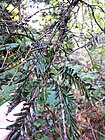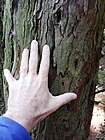Note: This is a project under development. The articles on this wiki are just being initiated and broadly incomplete. You can Help creating new pages.
Taxus brevifolia - Pacific yew
Taxus brevifolia is a conifer native to the Pacific Northwest of North America. It ranges from southernmost Alaska south to central California, mostly in the Pacific Coast Ranges, but with isolated disjunct populations in southeast British Columbia in north to central Idaho.
Contents
- 1 Uses
- 2 Parts Used
- 3 Chemical Composition
- 4 Common names
- 5 Properties
- 6 Habit
- 7 Identification
- 8 List of Ayurvedic medicine in which the herb is used
- 9 Where to get the saplings
- 10 Mode of Propagation
- 11 How to plant/cultivate
- 12 Season to grow
- 13 Soil type required
- 14 Ecosystem/Climate
- 15 Commonly seen growing in areas
- 16 Photo Gallery
- 17 References
- 18 External Links
Uses
Diphtheria, Tapeworms,, Swollen tonsils, Seizures, Muscle and joint pain, Urinary tract conditions, Liver problems, Breast cancer, Ovarian cancer.
Parts Used
Chemical Composition
The Pacific yew is poisonous because it contains at least 11 alkaloids, known collectively as taxines. The structure of only two of the alkaloid constituents is known: taxine A, which accounts for 30%, and taxine B, which accounts for 2%. Paclitaxel (Figure 128-1) is a pseudoalkaloid but not a constituent of taxine because its nitrogen is acylated with benzoic acid and has no basic principle.[1]
Common names
| Language | Common name |
|---|---|
| Kannada | |
| Hindi | Gallu, Thuno |
| Malayalam | |
| Tamil | |
| Telugu | |
| Marathi | NA |
| Gujarathi | NA |
| Punjabi | NA |
| Kashmiri | NA |
| Sanskrit | Manduparni |
| English | Himalayan Yew |
Properties
Reference: Dravya - Substance, Rasa - Taste, Guna - Qualities, Veerya - Potency, Vipaka - Post-digesion effect, Karma - Pharmacological activity, Prabhava - Therepeutics.
Dravya
Rasa
Tikta (Bitter), Kashaya (Astringent)
Guna
Laghu (Light), Ruksha (Dry), Tikshna (Sharp)
Veerya
Ushna (Hot)
Vipaka
Katu (Pungent)
Karma
Kapha, Vata
Prabhava
Habit
Identification
Leaf
| Kind | Shape | Feature |
|---|---|---|
| Simple | Alternate | Evergreen needles, single, spirally arranged |
Flower
| Type | Size | Color and composition | Stamen | More information |
|---|---|---|---|---|
| Unisexual | 2-4cm long | Yellow | 5-20 | Species is dioecious; male flowers are small, round, and yellow and are borne on the undersides of the leaves |
Fruit
| Type | Size | Mass | Appearance | Seeds | More information |
|---|---|---|---|---|---|
| round | 1/4 inch long | clearly grooved lengthwise, Lowest hooked hairs aligned towards crown | fleshy, orange-red | hard seed | {{{6}}} |
Other features
List of Ayurvedic medicine in which the herb is used
Where to get the saplings
Mode of Propagation
How to plant/cultivate
Thrives in almost any soil, acid or alkaline, as long as it is well-drained.[3]
Season to grow
Soil type required
Suitable for light (sandy), medium (loamy) and heavy (clay) soils and prefers well-drained soil.[4]
Ecosystem/Climate
Ponderosa pine, Western white pine, Fir - spruce, Hemlock - Sitka spruce, Larch, Redwood.[5]
Commonly seen growing in areas
Banks of mountain streams, Deep gorges and ravines, Borders of forests.
Photo Gallery
References
External Links
- Ayurvedic Herbs known to be helpful to treat Diphtheria
- Ayurvedic Herbs known to be helpful to treat Tapeworms,
- Ayurvedic Herbs known to be helpful to treat Swollen tonsils
- Ayurvedic Herbs known to be helpful to treat Seizures
- Ayurvedic Herbs known to be helpful to treat Muscle and joint pain
- Ayurvedic Herbs known to be helpful to treat Urinary tract conditions
- Ayurvedic Herbs known to be helpful to treat Liver problems
- Ayurvedic Herbs known to be helpful to treat Breast cancer
- Ayurvedic Herbs known to be helpful to treat Ovarian cancer
- Herbs with Fruits used in medicine
- Herbs with Seeds used in medicine
- Herbs with common name in Hindi
- Herbs with common name in Sanskrit
- Herbs with common name in English
- Habit - Evergreen tree
- Index of Plants which can be propagated by Seeds
- Herbs that are commonly seen in the region of Banks of mountain streams
- Herbs that are commonly seen in the region of Deep gorges and ravines
- Herbs that are commonly seen in the region of Borders of forests
- Herbs
- Taxaceae




